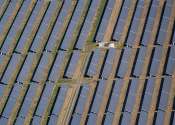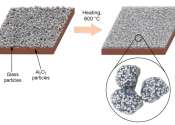Research shows how common plastics could passively cool and heat buildings with the seasons
Researchers at Princeton and UCLA have developed a passive mechanism to cool buildings in the summer and warm them in the winter.
Jun 27, 2024
0
54
Energy & Green Tech

Researchers at Princeton and UCLA have developed a passive mechanism to cool buildings in the summer and warm them in the winter.
Jun 27, 2024
0
54
Business

It sounds like a climate solution everyone should be able to support: Let's make it easier and cheaper for farmers with dwindling water supplies to convert their lands from crop production to solar energy generation, if that's ...
May 20, 2024
0
27
Engineering

In a move to embrace sustainable steelmaking, British Steel has unveiled a £1.25 billion plan to replace two blast furnaces at its Scunthorpe plant with electric arc furnaces. This follows the UK government's commitment ...
Dec 4, 2023
0
1
Engineering

University of Maryland researchers aiming to combat rising global temperatures have developed a new "cooling glass" that can turn down the heat indoors without electricity by drawing on the cold depths of space.
Nov 13, 2023
0
128
Energy & Green Tech

A shipping container that can test passive cooling systems could help researchers and builders find carbon-free ways to keep people cool in extreme temperatures.
Aug 22, 2023
0
1
Engineering

Temperatures around the world are soaring. Both California's Death Valley and China's Xinjiang region have seen temperatures climb above the 50℃ mark. A blistering heat wave is also sweeping across the Mediterranean, causing ...
Jul 21, 2023
1
33
Energy & Green Tech

Most oil majors are stepping up investment in green energy amid rising activist pressure but without abandoning fossil fuels, putting at risk reaching carbon neutrality in 2050.
May 26, 2023
0
22
Electronics & Semiconductors

In the effort to reduce our reliance on fossil fuels, one strategy involves harvesting the waste heat that is already being produced by our energy systems. Thermoelectric generators can convert waste heat to clean electricity, ...
May 1, 2023
0
49
Energy & Green Tech

Deployment of new wind and solar power plants needs to be drastically ramped up by the end of the decade to meet the world's climate goals, the International Renewable Energy Agency said Tuesday.
Mar 28, 2023
1
3
Energy & Green Tech

One-in-five new cars sold in California in 2022 was a zero-emission vehicle, the state said Friday, as the largest car market in the United States charges towards its goal of electrifying its fleet.
Jan 21, 2023
0
14
Climate encompasses the statistics of temperature, humidity, atmospheric pressure, wind, rainfall, atmospheric particle count and numerous other meteorological elements in a given region over long periods of time. Climate can be contrasted to weather, which is the present condition of these same elements over periods up to two weeks.
The climate of a location is affected by its latitude, terrain, altitude, ice or snow cover, as well as nearby water bodies and their currents. Climates can be classified according to the average and typical ranges of different variables, most commonly temperature and rainfall. The most commonly used classification scheme is the one originally developed by Wladimir Köppen. The Thornthwaite system, in use since 1948, incorporates evapotranspiration in addition to temperature and precipitation information and is used in studying animal species diversity and potential impacts of climate changes. The Bergeron and Spatial Synoptic Classification systems focus on the origin of air masses defining the climate for certain areas.
Paleoclimatology is the study and description of ancient climates. Since direct observations of climate are not available before the 19th century, paleoclimates are inferred from proxy variables that include non-biotic evidence such as sediments found in lake beds and ice cores, and biotic evidence such as tree rings and coral. Climate models are mathematical models of past, present and future climates.
This text uses material from Wikipedia, licensed under CC BY-SA